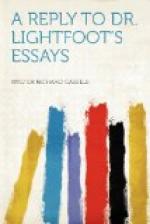That the statement of Malalas does not agree with the reports of the Fathers is no real objection, for we have good reason to believe that none of them had information from any other source than the Ignatian Epistles themselves, or tradition. Eusebius evidently had not. Irenaeus, Origen, and some later Fathers tell us nothing about him. Jerome and Chrysostom clearly take their accounts from these sources. Malalas is the first who, by his variation, proves that he had another and different authority before him, and in abandoning the martyr-journey to Rome, his account has infinitely greater apparent probability. Malalas lived at Antioch, which adds some weight to his statement. It is objected that so also did Chrysostom, and at an earlier period, and yet he repeats the Roman story. This, however, is no valid argument against Malalas. Chrysostom was too good a churchman to doubt the story of Epistles so much tending to edification, which were in wide circulation, and had been quoted by earlier Fathers. It is in no way surprising that, some two centuries and a half after the martyrdom, he should quietly have accepted the representations of the Epistles purporting to have been written by the martyr himself, and that their story should have shaped the prevailing tradition.
The remains of Ignatius, as we are informed by Chrysostom and Jerome, long remained interred in the cemetery of Antioch, but finally—in the time of Theodosius, it is said—were translated with great pomp and ceremony to a building which—such is the irony of events—had previously been a Temple of Fortune. The story told, of course, is that the relics of the martyr had been carefully collected in the Coliseum and carried from Rome to Antioch. After reposing there for some centuries, the relics, which are said to have been transported from Rome to Antioch, were, about the seventh century, carried back from Antioch to Rome. [111:1] The natural and more simple conclusion is that, instead of this double translation, the bones of Ignatius had always remained in Antioch, where he had suffered martyrdom, and the tradition that they had been brought back from Rome was merely the explanation which reconciled the fact of their actually being in Antioch with the legend of the Ignatian Epistles.
The 20th of December is the date assigned to the death of Ignatius in the Martyrology, [112:1] and Zahn admits that this interpretation is undeniable [112:2] Moreover, the anniversary of his death was celebrated on that day in the Greek Churches and throughout the East. In the Latin Church it is kept on the 1st of February. There can be little doubt that this was the day of the translation of the relics to Rome, and this was evidently the view of Ruinart, who, although he could not positively contradict the views of his own Church, says: “Ignatii festum Graeci vigesima die mensis Decembris celebrant, quo ipsum passum, fuisse Acta testantur; Latini vero die prima Februarii, an ob aliquam sacrarum ejus reliquiarum translationem? plures enim fuisse constat.” [112:3] Zahn [112:4] states that the Feast of the translation in later calendars was celebrated on the 29th January, and he points out the evident ignorance which prevailed in the West regarding Ignatius. [112:5]




